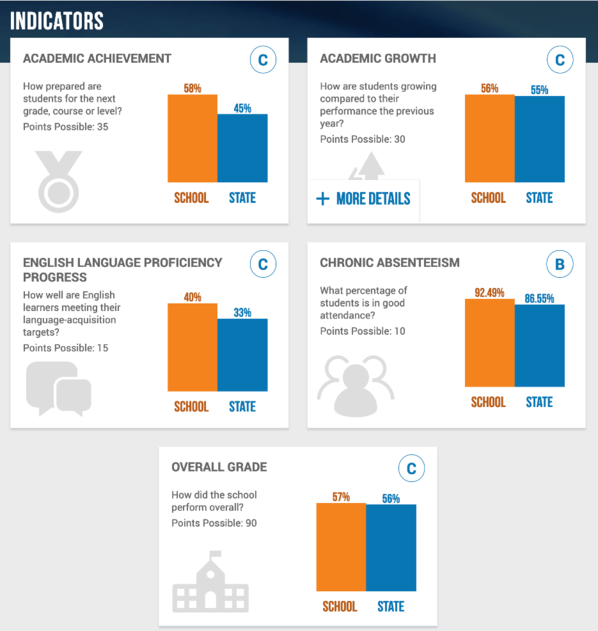State Board of Education approves Oklahoma School Report Cards
OKLAHOMA CITY (Feb. 28, 2019) – The State Board of Education (SBE) today approved release of the 2018 Oklahoma School Report Cards, introducing a school accountability system that corrects flaws in past iterations and provides a more comprehensive view of schools. They are available at http://oklaschools.com.
Under the federal Every Student Succeeds Act (ESSA) and a 2016 state law, House Bill 3218, the Oklahoma State Department of Education (OSDE) was required to develop a new school accountability system. State Superintendent of Public Instruction Joy Hofmeister then convened a 95-member task force representing a diverse range of education stakeholders to rethink how the state measures school performance. The resulting accountability system has moved from static, one-page documents focused on a single letter grade to an interactive, user-friendly dashboard-based platform that provides a snapshot of multiple aspects of school and student performance.
“The new system incorporates significantly more contextual information than its predecessor,” said Hofmeister. “The Oklahoma School Report Cards provide valid, reliable, meaningful and actionable data that schools and communities can use to improve outcomes for kids.”
 The new system measures up to four metrics, or indicators, for elementary and middle school sites and, for high schools, up to five indicators, plus an overall grade. The elementary/middle school indicators include academic achievement and English language proficiency (ELPA) progress for English learners, both required under ESSA; academic growth, which meets the ESSA requirement for a second academic indicator; and chronic absenteeism, one of the state’s two required nonacademic indicators of school quality or school success. High schools measure academic achievement, ELPA, chronic absenteeism, graduation and postsecondary opportunities, the state’s other nonacademic indicator. For additional information on each accountability indicator, click here.
Oklaschools.com is searchable by school, district address or county. Once a school has been selected, an overview page displays school information, while an additional click yields more contextual information, including school demographics and a breakdown of indicator scores for each federally recognized demographic group and comparisons to the district and state average.
 As required under ESSA, academic achievement and academic growth account for the highest number of possible points. Moreover, academic achievement in math, English language arts (ELA) and science is now measured on the basis of two factors – the degree to which students are meeting individual group targets as they work toward proficiency (14/15ths of the score) and the percentage of students reaching proficiency (1/15th of the score).
That is by design, said Hofmeister.
“It was important that the new system not have a myopic focus on spring state tests,” said Hofmeister. “The new system recognizes that all kids start at different places, and in fact was built on the belief that all students can grow and all schools can improve, no matter where they are today.”
A priority student group determines a student’s target score. Unlike in the previous system, students are counted only once to ensure that every student contributes equally to the indicator.
“No longer are we double- or triple-counting students with the greatest needs,” Hofmeister said. “In addition, we now have the ability to unmask previously hidden trends in student performance, particularly among historically under-represented populations of students.”
Academic growth measures the performance of individual students in consecutive years in mathematics or ELA. For the first time, schools will be recognized for the movement of all students in performance from one year to the next.
The old report card oversimplified the complex work of schools to a single letter grade, and critics decried low grades as no more than indicators of poverty. Hofmeister said that the new accountability system is a work in progress that will improve over time, but she is encouraged by early comparison data between the 2016 report card and the 2018 Oklahoma School Report Card that shows a nearly 40 percent decrease in correlation between the overall and academic achievement scores and poverty, and a nearly 50 percent decrease in correlation between the academic growth score and poverty.
“We know the world outside the classroom – where many of our students endure significant trauma, hunger and hardship – impacts the world inside the classroom,” she said. “Schools are working hard to meet students where they are and help move them toward a successful life after high school.
“No score or series of scores can tell the full story of a school and the life-changing work happening in Oklahoma schools. We are encouraged that the new accountability system provides a meaningful snapshot of where our schools are.”
OSDE will add contextual information as it becomes available. Among the additions are per-pupil expenditures, educator qualifications and statewide Programs of Excellence that, beginning next school year, will emphasize the importance of a well-rounded education and recognize schools making progress in the fine arts, STEM, social studies/civics, safe and healthy schools and world languages.
To see accountability resources, including e-learning modules devoted to each indicator and various data tables, click here.
###
|